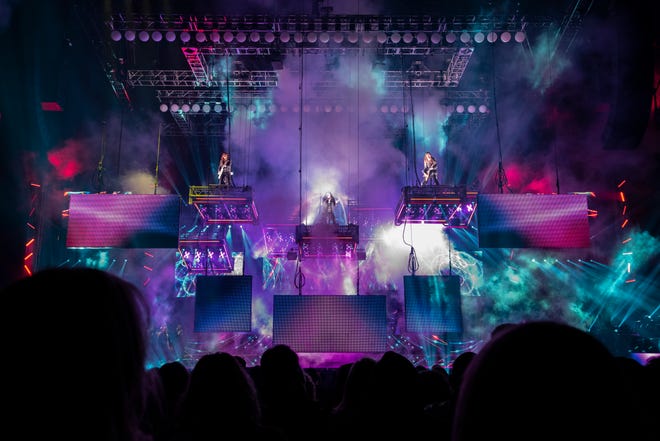
Trans-Siberian Orchestra reveals 2022 holiday tour dates and answers your burning questions
Melissa Ruggieri USA TODAY
Rare is the juggernaut as potent as Trans-Siberian Orchestra.
The musical locomotive – a gloriously grandiose combination of classical music, hair metal and holiday feels – has owned the road for more than two decades (virtually in 2020) and 2,000 shows.
This year’s tour, dubbed The Ghosts of Christmas Eve – The Best of TSO and More, pulls from TSO’s “The Ghosts of Christmas Eve” album and TV special, one of the enduring holiday classics created primarily by late founder, composer and lyricist Paul O’Neill.
The 60-city, 101-show outing runs Nov. 16 to Dec. 30; tickets go on sale Sept. 16 (10 a.m. local time) at the band’s website. ‘

But even with TSO’s immense popularity, questions persist from interested fans, from the meaning of the group’s name to their most popular songs.
We enlisted Al Pitrelli, longtime musical director and ace TSO guitarist for the West Coast touring production, to set some records straight.
What does TSO’s name mean?
You likely know it’s Trans-Siberian Orchestra, but where did that come from? In the mid-’90s, TSO spawned from Savatage, a progressive metal band. O’Neill produced and co-wrote with the band; Pitrelli played guitar.
Savatage scored an unlikely hit across multiple radio formats with the stirring guitar blaster “Christmas Eve/Sarajevo 12/24,” prompting O’Neill to spin off Savatage to record an album with a different band name and focus.
When he presented Trans-Siberian Orchestra to Pitrelli, the guitarist’s response was “Sure, it sounds cool, dude. Rolls off the tongue like Led Zeppelin would,” Pitrelli recalls with a laugh.
But the roots of the name are well-founded. O’Neill had traveled from Europe to Japan and was fascinated with Siberia, Pitrelli says. “And now, the name is synonymous with Christmas.”
What is Trans-Siberian Orchestra’s most well-known song?
Call it a trifecta of awesomeness.
Fans still thrill to “Christmas Eve/Sarajevo 12/24” because of its historical ties to TSO. But in 2004, “Wizards in Winter,” a kinetic marriage of orchestral rock, buzzing guitars and a memorable synth hook became an early viral hit when an electrical engineer in Ohio synchronized 16,000 Christmas lights on his house to every beat of the song. In 2005, Miller Brewing Co. turned the scene of colored lights and “Wizards” into a holiday commercial.Get the Everyone’s Talking newsletter in your inbox.
Get caught up with the trending news you need to knowDelivery: Mon – FriYour Email
And “Christmas Canon,” based on Johann Pachelbel’s “Canon in D Major,” has become so widespread, it’s often used as a wedding song. Or, in some cases, an engagement song.
“We’ll play it live and I’ll look down from the stage and see a dude on his knee,” Pitrelli says. “I’m looking down thinking, ‘This is going to go one of two ways.’ ”

Are there two Trans-Siberian Orchestras? How does that work?
“People think we have transporters, like the Starship Enterprise,” Pitrelli jokes.
So, yes, there are two bands divided between the East and West coasts, an evolution from TSO’s first tour of seven cities in 1999.
The popularity of that initial outing prompted O’Neill to staff two touring bands. Since TSO’s performance window is only about seven weeks during the holidays, time is imperative.
“We’d rehearse in two separate rooms in a studio in New York and Paul would bop back and forth between, making sure the bands sounded like a mirror image,” Pitrelli says.
In recent years, the two groups – each with a crew of about 100 – have rehearsed at an arena in Council Bluffs, Iowa, swapping between the main stage for full production run-throughs and the locker rooms to work on harmonies and musical details.
“My job is to maintain the musical integrity of the shows,” Pitrelli says. “If you go to your favorite steakhouse, you want exactly what you like every time.”

Is there a dress code for a TSO show?
Pitrelli laughs, which is an answer in itself.
“Nooooo, wear whatever you want. Just show up and have fun.”
He does, however, recall TSO’s debut as a band in 1999 at the Tower Theater in Philadelphia. “I looked out and saw a really attractive older couple in crocheted reindeer sweaters, and next to them was a dude in a Slayer hoodie.”
Does TSO ever lip sync?
“Absolutely not,” Pitrelli says with a touch of annoyance. “Some people, they’re naysayers and what, you want to discredit us? We’re just really good and practice really hard and every note is played live.”
How long does a TSO show last?
The production is presented in two halves, and the first hour is one of TSO’s patented “stories.” This year will feature the 10 songs from “The Ghosts of Christmas Eve.” (The album also had a companion TV special starring Ossie Davis.)
The second hour runs down other TSO classics from albums including “Beethoven’s Last Night,” as well as the treasured “Wizards in Winter.”
And, of course, “there will be more pyro, hydraulics and blowing stuff up,” Pitrelli promises.

Which charities does TSO donate to?
Since its inception, TSO has extended a charity arm in every city the bands play. Usually, the local concert promoter or radio station will earmark an organization – food banks, arts in schools programs – and TSO gives $1 from every ticket sold to the chosen charity. More than $18 million has been donated by the group through the years.
“That’s all Paul O’Neill and the O’Neill family,” Pitrelli says. “He always wanted to give back and not just come to town, do a show and leave. That was the least we could do.”
Is a TSO show appropriate for the whole family?
Pitrelli pegs the audience demographics as “2 to 92.”
“One of my favorite things is to see grandparents with a grandkid on their lap high-fiving and enjoying as a family,” he says. “It’s those little moments that mean the most.”
